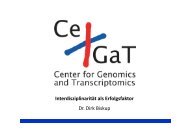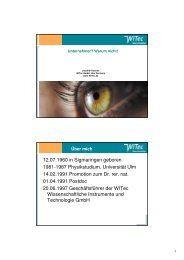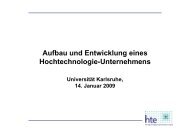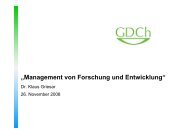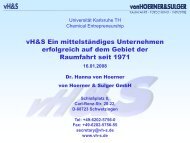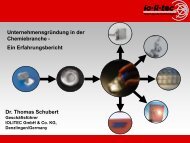Education in Chemical Entrepreneurship - KIT - Technology ...
Education in Chemical Entrepreneurship - KIT - Technology ...
Education in Chemical Entrepreneurship - KIT - Technology ...
Create successful ePaper yourself
Turn your PDF publications into a flip-book with our unique Google optimized e-Paper software.
The case orientation does not only refer to the course (lecture and exam<strong>in</strong>ation). Also<br />
the workshop on “f<strong>in</strong>anc<strong>in</strong>g models” uses the same set of cases that were available for<br />
the Certificate exam<strong>in</strong>ation (see above). This particular workshop aims at respond<strong>in</strong>g<br />
to a key factor among startup failures and <strong>in</strong>tends also to elaborate country-specific<br />
factors of technology entrepreneurship with practically relevant details. In contrast to<br />
the course the workshops require attendees’ preparations <strong>in</strong> terms of “directed<br />
read<strong>in</strong>gs”.<br />
A f<strong>in</strong>al remark concerns the characteristics of slides used for the course. Slides for the<br />
course are identical with the lecture scripts, which mean they do not comply with<br />
“good presentation practice”. The slides conta<strong>in</strong> often much text - with referral to the<br />
“standard” reference books. However, to emphasize key po<strong>in</strong>ts of a particular slide<br />
dur<strong>in</strong>g the lecture relevant terms or phrases are highlighted (“presentation bullets with<br />
a textual background”).<br />
Rationales for this approach, which was viewed as experimental to test 1) whether this<br />
k<strong>in</strong>d of approach is accepted and 2) how it is assessed, are as follows.<br />
� Attendees will be confronted with a special language (“bus<strong>in</strong>ess<br />
adm<strong>in</strong>istration”) with special terms and concepts they are generally not<br />
familiar with. Therefore, slides <strong>in</strong>clude often text (also full sentences) with<br />
explanatory character <strong>in</strong> the proper context to have “self-sufficient slides”.<br />
� Scripts/slides are provided as paper handouts for own mark<strong>in</strong>g or highlight<strong>in</strong>g<br />
and to make notes complement<strong>in</strong>g the slide content (or term translations) to<br />
create an <strong>in</strong>dividually “annotated presentation”.<br />
� It is a compromise between lecture <strong>in</strong> German and lecture scripts <strong>in</strong> English<br />
The <strong>in</strong>terest of the German chemical <strong>in</strong>dustry <strong>in</strong> education and skills specifically by<br />
this approach to “chemical entrepreneurship” was expressed through sponsor<strong>in</strong>g.<br />
BASF and Evonik Industries 10 did not only provide f<strong>in</strong>ancial support but participated<br />
actively <strong>in</strong> the course through guest speakers. Correspond<strong>in</strong>gly, the firm von Hoerner<br />
& Sulger (vH&S) supported the efforts through provision of a guest lecture without<br />
compensation for travel and accommodation 11 .<br />
4. Results<br />
Announcement of the curriculum was by common means of the university (dedicated<br />
Web site 1 , university course catalogue, e-mail to selected faculty members and<br />
pr<strong>in</strong>ted announcements on selected boards). Due to the low participation <strong>in</strong> the<br />
Certificate exam<strong>in</strong>ation (Figure 3, Exam.; four participants who all passed the<br />
exam<strong>in</strong>ation) students’ learn<strong>in</strong>g across the whole class cannot be reliably assessed.<br />
We had a further <strong>in</strong>dependent, but elementary degree of assessment of the design,<br />
content and the execution of the course through two anonymous questionnaires.<br />
Results from the relatively small samples were not subjected to any statistical<br />
procedures, but rather taken as “descriptive <strong>in</strong>dicators”. Even though this seems to be<br />
a reasonable measure of satisfaction, we are aware that this k<strong>in</strong>d of <strong>in</strong>strument does<br />
not state directly whether the participants learned anyth<strong>in</strong>g (Alberti, S. Sciascia, and<br />
A. Poli. 2004).<br />
After the first lecture a questionnaire focused essentially on<br />
� Demographics of attendees (<strong>in</strong>clud<strong>in</strong>g discipl<strong>in</strong>e, gender, level of university<br />
eduction)<br />
� Assess<strong>in</strong>g the duality of English slides versus German talk<strong>in</strong>g<br />
Runge and Bräse - 15 -



